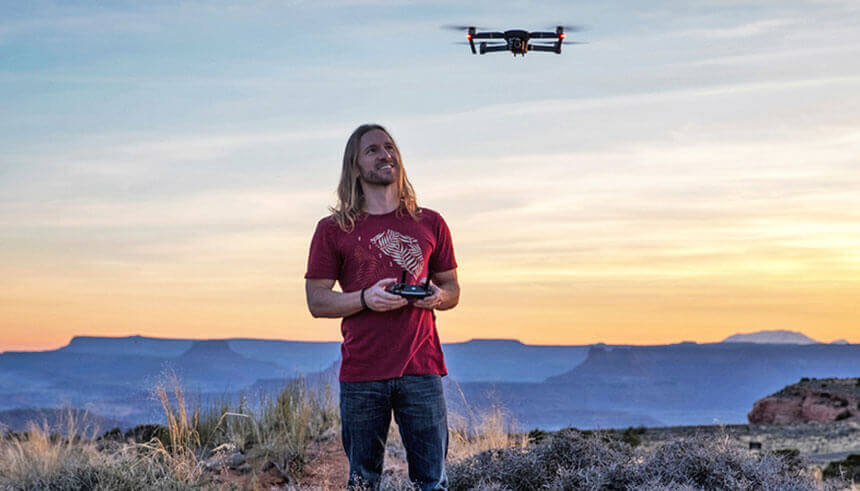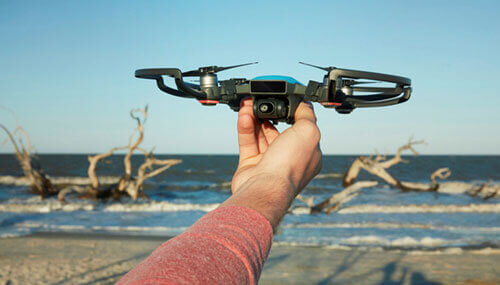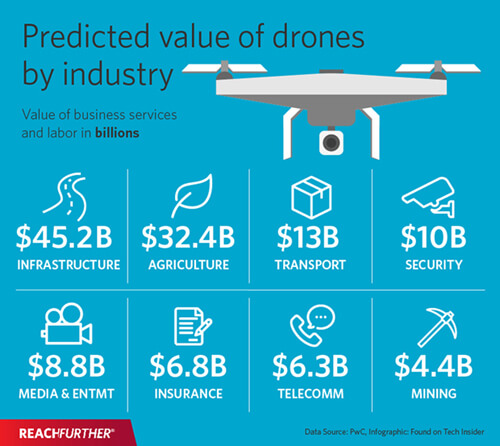U.S.-Asia Business
Drones: All the Buzz in US-China Business
By Melody Yuan

The scale and scope of drones will continue to soar in markets from US to China.
Drones are becoming more prevalent in our skies, as its popularity rises among businesses and consumers. One company that has come out on top is DJI Innovation Technology Co. (DJI), a drone company headquartered in Shenzhen, China, and lives up to their tagline: the future of possible. With the drone market predicted to surpass $11 billion by 2020, DJI is positioned favorably. The Federal Aviation Authority (FAA) estimates that by 2020, 15,000 civilian drones will be flying around the U.S., and research firm NPD Group estimated that U.S. sales of drones were increasing at a fast rate of 117 percent year-over-year. Of this market, DJI has captured 66 percent for drones priced between $1,000 and $2,000, and 67 percent of the market in the $2,000-4,000 range. Across all drone prices, DJI has captured more than 50 percent of the North American market.
How did one company come to dominate such a big share of the global drone industry?
“Accessibility, safety and ease of use are all things that we’ve collectively been working on since day one to remain competitive in the market and continually improve our products,” says Kevin On, director of communications at DJI.
Brian Lee, marketing director of DJI, says, “We have 75 percent of the drone market share in the world today. Constant innovation is our driving force and, without creativity and innovation, we’d be nowhere today.” Despite humble beginnings in 2006 crafting flight controllers geared toward helicopters, the company has since grown exponentially and employs more than 11,000 people today, of which 25 percent are engineers. Drones are not the only products DJI invests R&D toward; they also actively participate in supporting technologies such as aircraft systems, gimbals and aerial cameras. DJI makes a point to retain their employees in-house to protect their intellectual property. “We put a lot of investment into our own R&D, and there’s a lot of internal competition in-house to produce the most compelling and innovative products,” says Lee. “This is how we maintain our competitive nature within our company and also outcompete others in the same industry.”
“It’s really an interesting time to be working in this field, especially right now as the drone market continues to grow,” says On.
China’s drone market
While the numbers for drone use are rising in the U.S., China is leagues ahead when it comes to technology integration across consumers and enterprises. According to market research firm International Data Corp (IDC), China’s civil aerial photography drones have an annual growth rate of 122.4 percent, and shipments are expected to reach 5.46 million by 2020. Of those shipments, 3 million will be consumer-level drones.
“The commercial drone market will grow steadily, but the consumer drone market has just started to boom,” says Xiao Jing, research manager of IDC China.
In the U.S., the conversation around drones is still met with skepticism and even fear of privacy violations. In China, however, other major technology giants such as smartphone manufacturers Xiaomi Corp, LeEco Holdings Ltd., and Meitu Inc. have all launched their own drones with the hopes of expanding their consumer base. Other forms of technologies have also been combined with the use of drones; one, in particular, that has gained popularity is virtual reality (VR). Drones with 360 degree cameras that simultaneously use VR technology give users a completely new, immersive flying experience.
DJI in particular is the strongest drone brand in China. “We’ve been regarded as the hero brand,” says On. “We started in China, and, through innovation and technology, we’ve become a key player in the global market.” Geographically speaking, On believes that flying a drone in the U.S. is easier because there is access to more open lands. Users in Asia, on the other hand, find it difficult to fly their drones freely in urban spaces and require more skilled maneuverability to avoid obstacles in the air.
Business applications growing
Despite the drone industry still being in its nascent stages, a number of businesses across core industries have already embraced the technology and have seen immense benefits. “Our strategic direction includes five different industries of focus,” says On. “We’re all about making this technology more accurate to help bring tangible business results to our clients.”
One of the first industries that adopted this technology was entertainment, specifically for cinematography uses. Given the drones’ accurate aviation capabilities and potential to capture unique camera angles, the technology was quickly incorporated into the industry. The second industry to rely on drones was agriculture, given the drones’ multifunctional ability to help farmers accomplish tasks such as watering fields, spraying agents on the right crops (which also minimizes health risks), and quickly identifying problem areas on their property. “Based on academic reports, in about 50 years we’ll be facing the imminent problem of running out of food,” says On. “That’s why we’re thinking of ways to help farmers more efficiently produce the crops that they need by using our technology to cut down their manual labor hours.”

"We started in China, and, through innovation and technology, we’ve become a key player in the global market."
The infrastructure industry has also begun to use drones to assess planning areas, construction sites, buildings, and bridges to mitigate human injuries caused by sending workers to potentially dangerous sites. In line with lowering the risks of workers getting injured, the energy sector has also started using drones to survey places such as turbines, nuclear power plants and dams. “Imagine something on a smaller scale, like inspecting damaged powerlines along the highway,” says On. “In the past, you had to send over individual workers to climb poles and inspect the powerlines one by one. Then they had to climb down, pick the right tools, and have to climb back up to repair the damage. It’s time-consuming and dangerous. Now, you can just fly a drone over the powerlines, use a zoom camera, identify the problem, and then send workers over with the right tools to fix the problem.”
Drones are making enterprises move more efficiently by helping them save time and money, while lowering accident risks. The fifth and final industry that DJI is focused on is emergency response. For example, as opposed to just using pilots and search-and-rescue teams to look for missing persons from a helicopter, drones can fly lower to the ground and through narrower spaces to better scan areas. In fact, drones have already successfully been used to find a missing elderly woman in North Carolina. Teams could also attach a thermal energy camera to drones to more accurately search for bodies. For firefighters, drones can be used to identify the root cause and direction of the fire while accurately analyzing the environment and risks involved without having to put anyone in harm’s way.

Consumers flying drones today
Individual consumers and drone companies are still searching for the sweet spot in terms of best-uses. While drones are becoming more accessible in price and user-friendliness, the technology will go through many more iterations before being accepted by the mainstream consumer. “There’s still a big learning curve waiting to happen on the end of the consumer,” says On. “We see a big opportunity for growth here.”
Most personal-use examples revolves around niche audiences, such as photographers or remote control flight enthusiasts. There are, however, a few unique use-case scenarios that DJI and other companies have been trying to tap into. “Look at the people who love to travel,” says On. “Everyone wants to tell their travel stories in a unique way and, today, more travelers are incorporating drone technology to do that.”
DJI has created released two drones to appeal to the selfie culture: the Mavic Pro and Spark. Both drones have mechanical capabilities to make taking camera footage much easier for consumers. The Spark, in particular, is priced at an accessible $499, weighs only half a pound, and is about the size of a soda can. More impressively, the drone uses gesture and facial recognition to ensure that it captures photos from the best angles. “Gone are the days of selfie sticks,” says Lee. “We’re raising the selfie bar with our drones.”
Working through flight limitations
The future and adoption of drones is contingent on improving some of the existing limitations. On the technology side, as with any electronic device, the question of battery life is always a big factor. Most drones today use lithium-polymer batteries, which is the most efficient method to maximize flight time and keep drones light. With an average airtime between 10 to 20 minutes, drones currently can’t stay out for too long. Computer vision, which is the ability to recognize objects and track potential obstacles, is also an area that is being improved. Many drones use dual cameras in the front that function as obstacle avoidance cameras, with the ability to capture and transmit 3D images.
On the policy side, drones face different regulations at various stages, across different countries. While the FAA has established airspace restrictions and no drone zones with safety guidelines for users, the specifics still need to be hashed out. In addition to adhering on the federal level, drone companies must also understand regulations on the state and city levels, which all have different policies. “There’s no best regulation, since each area is different,” says On, “but ultimately our goal is to have close and frequent discussions with aviation authorities in the countries that we operate to ensure that what we propose is balanced and helps protect our skies, while also continuing to make them open to innovation.”
Safety is a big priority for DJI and implementing parameters such as permanent and temporary no-fly zones into their satellite systems is one example of their efforts. Data protection to keep information gathered during the flight away from hackers is also a consumer and enterprise safety precaution. Users simply turn on the local data mode (LDM) of their drones to disable the internet and, subsequently, any data collected from the flight will only be saved to the drone’s memory card. For regulators, DJI recently launched their AeroScope technology that allows for aviation authorities to detect drones that are approaching restricted perimeters. Areas with high security concerns such as airports or government buildings will be able to better manage drone traffic and prevent accidents through AeroScope. The information that will be transmitted to authorities will be limited to the drone’s serial number, location, speed, and altitude at which they’re flying. “We take safety very seriously,” says On. “Our D.C. and New York offices work closely with the FAA to ensure we’re able to have safer skies that are open to innovation.”
The future of drones and the role of DJI
Strong worldwide sales of DJI drones indicate that the company will most likely continue its stronghold over the market. DJI’s most popular drone models include the Phantom series, which has been around since 2012, and is recognized worldwide with its aesthetic form and iconic white color. The most recent launch of the Mavic Pro and Spark series opened new opportunities for the company, given the drones’ smaller size and user-friendly interfaces. “Since these drones were released, we’ve received a lot of attention and customer engagement,” says On. DJI launched the Matrice 200, made specifically for enterprises, earlier this year, equipped with top and bottom cameras, redundancy, and durability against harsh external conditions. Beyond the hardware, DJI is also updating its software with programs like Ground Station Pro, which can be downloaded on smart devices to create 3D maps to analyze data in a matter of minutes.
“If you look at what’s out there now, in terms of a competitor that covers a wide range of the drone technology portfolio like ours, there’s not a whole lot,” says On. DJI covers a large space in the technology, and analysts within the company estimate that they are two years ahead of their closest competition. Lee and On both attribute the success of their company to “boot-strapping,” which they refer to as the process of investing the profits back into the company’s R&D. “If you look at our product life cycle, we come out with something new every six months, which is an incredibly fast turnaround,” says On. Lee also mentions the steadfast mentality of their CEO, Frank Wang, along with the rest of upper management. “Someone could be making something better to outdo you tomorrow,” says Lee. “We’re always thinking of what we can do next.”

